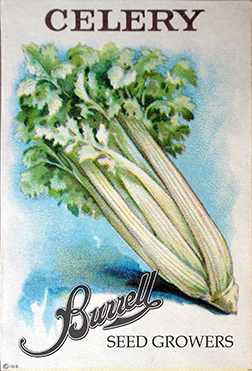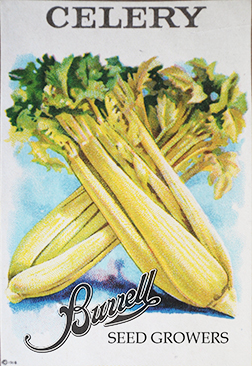Growing Celery.
Celery is a mainstay in many kitchens. It is a healthy after school/work snack filled with peanut butter or cream cheese. In soups, stews and salads, a necessity. This common place, crunchy vegetable has been taken for granted and its’ impressive nutritional benefits are often overlooked.
GROWING AND HARVESTING CELERY
Celery requires an abundance of moisture at all stages of growth but will not endure flooding for any length of time. Seed is sown from February to May in beds either drilled or broadcast. This seed must be planted very shallow, is slow to germinate and the bed must be kept wet. The beds may be covered with burlap sacks until the plants begin to come to the surface, when the sacks must be removed at once. The seedlings will be ruined if the sacks are left on even one day too long. After the seedlings are well started, they may be transplanted or thinned out to give them room to make stocky plants. If broadcast, seedlings should be two or three inches each way or if in drills, one inch apart in six inch rows will give strong plants. Usually three months will be required for seed to produce a plant ready to transplant into the
field. Celery plants are usually set in 3′ to 4′ foot rows plants placed about 7 inches apart in the row. Frequent cultivation and irrigation
is necessary; an abundance of fertilizer must be used unless the soil is exceptionally rich. As the plants approach maturity they must be blanched by hilling with earth or with boards or special blanching paper. Late celery should be trenched at the approach of freezing
weather. The trench should be dug in well drained soil 12 to 15 inches wide, as deep as the plants are tall and as long
as desired. Dig the plants with roots on and set them close together in the trench, watering the soil about the roots, but careful to keep the tops dry. Should the plants begin to wilt, water the roots without wetting the stalks or leaves as this will cause rotting. Cover. with boards to shade and keep temperature above freezing point when the weather gets cold by adding straw covered with soil as required. The stalks are gradually blanched and may be used during the winter. No vegetable requires more careful handling in seed production than Celery.
Good companion crops are beans, leeks, onions, tomatoes and spinach. Bad companion crops are corn, asters and potatoes.
Growing Celery.
Celery is a mainstay in many kitchens. It is a healthy after school/work snack filled with peanut butter or cream cheese. In soups, stews and salads, a necessity. This common place, crunchy vegetable has been taken for granted and its’ impressive nutritional benefits are often overlooked.
In a garden, celery is often considered the ultimate challenge. Celery does not like extreme heat or cold and requires a long season. Celery seedlings are most often started in inside 8 to 10 weeks before the last frost date. Starting tiny celery seeds takes care. Mix them with a small amount of sand and sprinkle on top of a good potting soil. Once large enough (6″ tall), and the soil temperature reaches 50º, transplant individual plants outdoors. Space 6″ to 8″ apart, in rows 2′ to 3′ apart. Keep moist throughout the entire growing season. Celery does not tolerate any drought. Soil should have a high content of organic matter with plenty of composted manure.
Good companion crops are beans, leeks, onions, tomatoes and spinach. Bad companion crops are corn, asters and potatoes.



